Discover beginner, intermediate, and advanced routines, plus expert tips on exercise, nutrition, and motivation. Unleash your fitness potential – start your 20-minute journey today!
Introduction
Do you crave effective fitness but struggle to squeeze hours into your gym routine? Juggling work, family, and social life can leave you feeling like there’s never enough time to prioritize your health.
Fear not, fitness warriors! This blog post is your battle cry against time constraints. We’re unleashing a powerful arsenal of 20-minute full-body workouts designed specifically for gym-goers like you. Whether you prefer bodyweight, equipment-based, high-intensity, or low-impact exercises, we have options to maximize your time and supercharge your results.
Forget sacrificing effectiveness for speed. These workouts pack a punch, targeting all major muscle groups and delivering a time-saving, energy-boosting experience. You’ll sculpt, strengthen, and sweat your way to a fitter, healthier you, all within 20 minutes.
Ready to unlock the door to fitness freedom? Dive into our diverse workout library and find the perfect routine to match your style and goals. Let’s unleash your inner fitness champion, one quick and effective workout at a time!
P.S. Stay tuned for expert tips, modifications, and bonus routines to keep your fitness journey dynamic and exciting!
Benefits of a 20-Minute Full-Body Workout
Tired of spending hours at the gym with minimal results? Craving a workout that fits seamlessly into your packed schedule? Look no further than the game-changing power of 20-minute full-body workouts! These condensed routines provide a potent punch, delivering a multitude of benefits for gym-goers on the go:
1. Time Efficiency for Busy Schedules: Ditch the guilt of skipped workouts! These quick routines empower you to prioritize fitness without sacrificing precious time. Squeeze in a sweat session before work, during your lunch break, or even after dinner – the choice is yours!
2. Total Body Engagement for Maximum Results: Don’t let the brevity fool you. These workouts hit all major muscle groups, ensuring an even and efficient sculpting of your entire physique. No more isolated exercises – get a complete workout in just 20 minutes!
3. Increased Strength and Endurance: By utilizing compound movements and challenging your body in diverse ways, these routines promote both strength and endurance gains. Witness improved performance in other activities and daily life!
4. Enhanced Metabolic Boost: Get ready to burn calories even after your workout ends! The intensity and full-body focus trigger an elevated metabolic rate, helping you shed fat and tone your body more effectively.
5. Improved Mental Clarity and Mood: Exercise is a well-known stress reliever and mood booster. These quick workouts deliver a potent dose of both, leaving you feeling energized, focused, and ready to tackle your day!
Ready to unlock the transformative power of 20-minute full-body workouts? Explore our diverse routine library and discover the perfect fit for your fitness goals and schedule. Remember, small changes can lead to big results – start your journey today!
Warm-Up
Don’t Skip the Prep: The Crucial Warm-Up Before Your 20-Minute Blitz
Before you dive headfirst into your high-powered 20-minute workout, remember: a proper warm-up is your body’s best friend! Just like a car needs to crank up before speeding off, your muscles and joints need preparation to perform at their best and avoid injury.
Here’s why a warm-up is essential:
-
Increased Blood Flow: Think of your warm-up as a gentle nudge to wake up your circulatory system. It elevates your heart rate and delivers oxygenated blood to your muscles, preparing them for action.
-
Enhanced Muscle Elasticity: As your muscles warm up, they become more pliable and less prone to tears or strains. Think of it as stretching warm taffy instead of cold, brittle candy!
-
Improved Joint Mobility: Your joints also benefit from gentle movement. Warming them up improves lubrication and increases your range of motion, ensuring smooth and efficient exercise.
-
Boosted Mental Focus: A dynamic warm-up gets your mind in the game. You’ll transition from a relaxed state to a focused readiness for your upcoming physical challenge.
Now, let’s talk tactics:
-
Start Low and Slow: Begin with light cardio activities like brisk walking, jumping jacks, or jogging. Gradually increase your pace and intensity as you warm up.
-
Embrace Dynamic Stretching: Ditch the static stretches! Instead, incorporate dynamic movements that mimic the actions you’ll perform in your workout. Think arm circles, leg swings, and lunges with torso twists.
-
Engage Mobility Drills: Focus on movements that improve joint mobility, like shoulder rolls, hip circles, and ankle rotations. These will unlock your full range of motion and ensure smooth, pain-free exercise.
-
Listen to Your Body: Don’t push yourself too hard. Your warm-up shouldn’t leave you exhausted. Aim for a light sweat and increased heart rate as signs you’re ready to conquer your workout.
Remember, a proper warm-up takes just a few minutes but can save you from injuries and ensure a more productive and enjoyable fitness experience. So, make it a non-negotiable part of your 20-minute routine!
20-Minute Full-Body Workout Routine
Unleash the Beast in 20 Minutes: Your Full-Body Circuit Training Blitz
Now it’s time for the main event! Get ready to unleash your inner fitness beast with this electrifying 20-minute full-body circuit training routine. This high-intensity, low-equipment workout blasts every major muscle group, maximizing your results in minimum time.
Format:
- Perform each exercise for 30 seconds with 15 seconds of rest in between.
- Complete the entire circuit 3 times with a 30-second rest between each circuit.
- For an extra challenge, shorten your rest periods or increase the number of circuits.
Exercises:
1. Jumping Jacks (Upper Body & Lower Body)

- A classic warm-up and calorie burner. Engage your arms and legs with explosive jumps, raising your heart rate and getting your blood pumping.
2. Push-Ups (Upper Body)
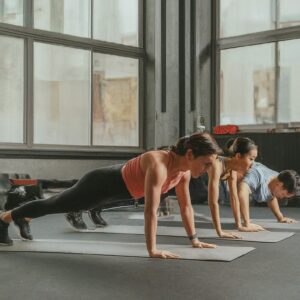
- The ultimate upper-body test. Modify on your knees or against a wall if needed. Feel the burn in your chest, shoulders, and triceps!
3. Squats (Lower Body)

- King of lower-body exercises. Target your quads, glutes, and hamstrings with deep, controlled squats. Use dumbbells for added intensity.
4. Mountain Climbers (Core & Lower Body)
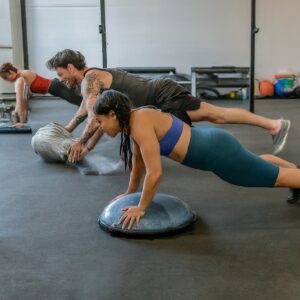
- Engage your core while working your legs with this dynamic exercise. Alternate bringing your knees towards your chest in a running motion.
5. Plank (Core)
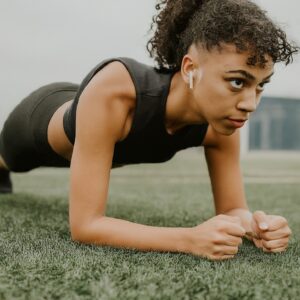
- The ultimate core challenge. Hold a high plank for as long as possible, engaging your entire core for stability and strength.
6. Lunges (Lower Body)
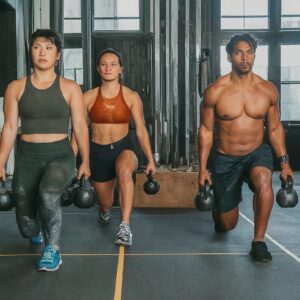
- Sculpt your legs and glutes with alternating lunges. Step forward with one leg, bending both knees, and push back to starting position. Add weights for an extra challenge.
7. Superman (Back & Core)

- Lie on your stomach, extend your arms and legs, and lift your chest and limbs off the ground. Work your back muscles and core for improved posture and stability.
8. Burpees (Full Body)
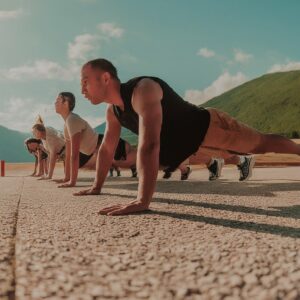
- The ultimate full-body challenge. Squat, jump back to plank, do a push-up, jump your feet back in, and stand up with a jump. Feel the burn everywhere!
Modification Options:
- Beginner: Shorten the exercise duration, increase rest periods, or choose lower-impact alternatives like walking lunges or wall push-ups.
- Intermediate: Increase the number of repetitions, shorten rest periods, or add weights for an extra challenge.
- Advanced: Perform plyometric variations like jump squats or jumping lunges, shorten rest periods even further, or add more weight.
Remember: Always listen to your body and modify as needed. This routine is a starting point, not a one-size-fits-all solution. Adjust to your fitness level and goals for optimal results.
Upper Body Exercises
Great choices for your upper body routine! While you’ve listed three fantastic exercises, let’s expand your arsenal with options catering to different fitness levels and equipment availability. Remember, you can tailor this to your specific needs and preferences.
Push-Ups:
- Classic Push-Up: The king of upper body exercises, targeting chest, shoulders, and triceps. Modify on knees or against a wall for beginners.
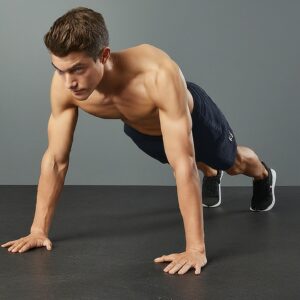
Classic Push-Up - Incline Push-Up: Elevate your hands on a step or bench to make it easier.
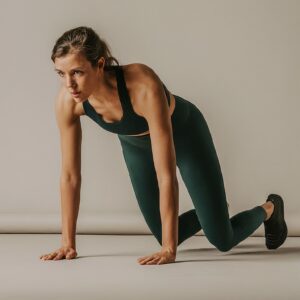
Incline Push-Up - Decline Push-Up: Place your feet on a step or bench for an increased challenge.

Decline Push-Up - Diamond Push-Up: Bring your thumbs and index fingers together for triceps focus.
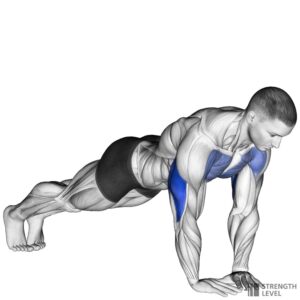
diamond-push-ups
Dumbbell Rows:
- Bent-Over Row: Hinge at the hips, back straight, and row dumbbells towards your chest, working upper back and biceps.
- Seated Cable Row: Sit at a cable machine and pull the cable towards your chest with controlled movements.
- Single-Arm Dumbbell Row: Offer greater core engagement and unilateral focus.
- Inverted Row: Use TRX straps or rings to row your bodyweight, perfect for beginners.
Shoulder Presses:
- Overhead Press: Stand or sit and press dumbbells or a barbell overhead, targeting shoulders and triceps.
- Arnold Press: Perform a circular motion with the dumbbells while pressing, hitting different shoulder sections.
- Military Press: A strict press straight overhead, emphasizing core stability and shoulder strength.
- Lateral Raise: Lift dumbbells out to the sides, targeting deltoids for sculpted shoulders.
Bonus Exercises:
- Bicep Curls: Build those arm muscles with dumbbell curls or hammer curls.
- Tricep Extensions: Target the back of your arms with overhead extensions or tricep dips.
- Plank Variations: Engage your core while strengthening shoulders with high planks, side planks, or plank rows.
Modification Tips:
- Reduce weight: Use lighter weights or perform bodyweight variations.
- Shorten range of motion: Don’t go as low or high with certain exercises.
- Increase rest periods: Take longer breaks between sets.
- Use alternative exercises: Choose low-impact options like seated rows or wall push-ups.
Remember, the key is to find exercises you enjoy and can do safely while progressively challenging yourself. Consistency is crucial for results!
Further Customization:
- Split the routine: Do Push-Ups and Tricep exercises one day, and Rows and Shoulder exercises on another.
- Increase intensity: Try supersets (doing two exercises back-to-back) or shorter rest periods.
- Add in core exercises: Integrate planks, crunches, or Russian twists for a full-body workout.
Lower Body Exercises
You’ve chosen three excellent lower body exercises that form the foundation of many effective routines. To further expand your options, consider incorporating variations and additional exercises based on your equipment availability and fitness level:
Squats:
- Classic Squat: The standard, bodyweight option targeting quads, glutes, and hamstrings.
- Sumo Squat: Wider stance with toes pointed outwards, emphasizing inner thighs.
- Pistol Squat: Single-leg squat for advanced balance and strength challenge.
- Weighted Squat: Use dumbbells, barbell, or kettlebells for added resistance.
- Jump Squat: Explode upwards for plyometric power and cardio benefits.
Lunges:
- Walking Lunges: Step forward with one leg, then bring the other leg to meet it, repeating with the other side.
- Reverse Lunges: Step backwards with one leg, lowering your hips, then push back to starting position.
- Static Lunges: Hold each lunge position for an isometric challenge.
- Weighted Lunges: Use dumbbells or kettlebells in each hand.
- Side Lunges: Step out to the side with one leg, bending at the hip and knee, then return to center.
Deadlifts:
- Conventional Deadlift: Standard deadlift using barbell or dumbbells, working hamstrings, glutes, and lower back.
- Romanian Deadlift: Focuses more on hamstrings by hinging at the hips and lowering the weight close to your legs.
- Single-Leg Deadlift: Advanced variation challenging balance and core stability.
- Sumo Deadlift: Wider stance for increased glute activation.
- Trap Bar Deadlift: Easier on the lower back compared to conventional deadlift.
Bonus Exercises:
- Step-Ups: Use a bench or stair to step up with one leg, working glutes and quads.
- Calf Raises: Raise your heels on your toes, targeting calf muscles.
- Glute Bridges: Lift your hips off the ground while lying on your back, engaging glutes and hamstrings.
- Hip Thrusts: Push your hips upwards from a seated position, emphasizing glutes.
Modification Tips:
- Reduce weight: Use lighter weights or bodyweight variations.
- Elevate heels: Place a small plate or book under your heels for better squat depth.
- Shorten range of motion: Don’t go as low with squats or lunges.
- Use alternative exercises: Choose options like wall squats or seated calf raises.
Further Customization:
- Supersets: Combine squats and lunges, deadlifts and calf raises, for increased intensity.
- Circuit training: Perform all exercises back-to-back with short rest periods.
- Focus on specific muscle groups: Choose exercises targeting quads, glutes, hamstrings, or calves specifically.
Core Exercises
Your choices for core exercises are diverse and effective! Planks, Russian twists, and bicycle crunches target different aspects of your core, making them a great foundation for a well-rounded routine. Here are some ideas to expand your options and cater to different fitness levels:
Plank Variations:
- High Plank: Standard plank position on forearms or hands, engaging entire core.
- Side Plank: Plank on one forearm with your body in a straight line, targeting obliques and side core.
- Low Plank: Plank on forearms with elbows close to the body, emphasizing shoulders and upper core.
- Anti-Plank: Lie on your back with arms and legs extended, lifting your lower back and legs off the ground for a reverse core challenge.
- Walking Plank: Plank with hands or forearms, taking alternating steps forward and back with your hands or feet for added core stability and dynamic movement.
Russian Twist Variations:
- Seated Russian Twist: Sit with knees bent and feet flat, rotate your torso while holding a weight or medicine ball.
- Kneeling Russian Twist: Kneel on the ground with a slight lean back, rotate your torso while holding a weight or medicine ball.
- Standing Russian Twist: Stand with feet shoulder-width apart, rotate your torso while holding a weight or medicine ball.
- Weighted Russian Twist: Use heavier weights or medicine balls for increased resistance.
- Medicine Ball Slam with Twist: Hold a medicine ball overhead, slam it down, and twist your torso as you bend to pick it up.
Bicycle Crunch Variations:
- Classic Bicycle Crunch: Lie on your back, bring one knee towards your chest while rotating your opposite elbow towards it, repeat with the other side.
- Flutter Kicks: Lie on your back, lift your legs slightly off the ground and perform small alternating kicking motions.
- Scissor Kicks: Lie on your back, lift your legs straight and perform alternating scissor kicks.
- Russian Twist Crunches: Combine a Russian twist with a crunch movement for a more complex core challenge.
- Leg Raises: Lie on your back and lift both legs straight up at once, lowering them slowly with control.
Bonus Exercises:
- Hollow Body Hold: Lie on your back with your lower back pressed to the ground, lift your shoulders, arms, and legs slightly off the ground.
- Dead Bug: Lie on your back with arms and legs extended, slowly lower one leg and arm at a time while keeping your lower back on the ground.
- Bird Dog: Start on all fours, extend one arm and opposite leg out straight, hold for a moment, then switch sides.
Modification Tips:
- Reduce range of motion: Don’t go as low with crunches or planks.
- Use lighter weights or no weights at all.
- Focus on slow and controlled movements.
- Choose exercises that don’t cause pain.
Further Customization:
- Circuit training: Perform all exercises back-to-back with short rest periods.
- Interval training: Alternate between periods of high-intensity core work and rest.
- Supersets: Combine core exercises with upper body or lower body exercises for a full-body workout.
Cooldown
Cool Down: Don’t Just Stop, Wind Down!
Just like a car needs to cool down after a long drive, so does your body after a workout. Skipping the cooldown can leave you feeling stiff, sore, and prone to injury. Let’s explore the importance of a proper cooldown and effective techniques to wind down your 20-minute fitness journey.
Why Cool Down?
- Gradually reduces heart rate and blood pressure: This prevents post-exercise dizziness and lightheadedness.
- Improves circulation: Helps remove metabolic waste products like lactic acid, reducing muscle soreness.
- Maintains flexibility: Static stretches after exercise help improve your range of motion and prevent stiffness.
- Promotes relaxation: Calming down both your body and mind helps you transition from workout mode to daily life.
Static Stretching:
- Hold each stretch for 20-30 seconds, repeating 2-3 times.
- Focus on major muscle groups worked during your workout.
- Breathe deeply and slowly throughout the stretch.
- Don’t bounce or force the stretch.
Effective Stretches:
- Quadriceps stretch: Stand tall, hold one foot behind your calf, and gently pull your heel towards your buttocks.
- Hamstring stretch: Sit on the floor with legs extended, reach towards your toes or shins without rounding your back.
- Calf stretch: Lean against a wall with one leg forward and the other straight back, push your heel down towards the floor.
- Chest stretch: Clasp your hands behind your back and gently push your chest forward.
- Triceps stretch: Reach one arm overhead, bend at the elbow, and use your other hand to gently pull your elbow behind your head.
- Shoulder stretch: Interlace your fingers behind your back and gently push your palms down towards the ground.
Relaxation Techniques:
- Deep breathing: Inhale slowly and deeply through your nose, exhale slowly through your mouth.
- Progressive muscle relaxation: Tense and relax different muscle groups one by one.
- Guided meditation: Focus on calming thoughts and imagery.
- Light foam rolling: Gently roll out major muscle groups to release tension.
Remember:
- Listen to your body: Don’t push yourself too hard during the cooldown.
- Adapt to your workout: Tailor your stretches and relaxation techniques to the exercises you performed.
- Make it a habit: Integrate the cooldown into your routine for optimal results and injury prevention
Tips for Maximizing Results
Unlock Your Full Potential: Maximize Your 20-Minute Workouts
You’ve got the exercises, the structure, and the cooldown – now let’s elevate your 20-minute workouts to the next level with these key tips:
1. Master the Moves: Focus on Form and Technique
Remember, it’s not just about reps and speed – proper form is the foundation for maximizing results and preventing injury. Pay attention to:
- Muscle engagement: Feel the target muscle working throughout the exercise.
- Body alignment: Maintain a neutral spine and correct posture.
- Full range of motion: Move through the entire exercise without compromising form.
- Controlled movements: Avoid jerky or bouncing motions.
- Seek guidance: Don’t hesitate to ask a trainer or watch demonstration videos to ensure proper technique.
2. Tailor the Intensity: Align with Your Goals
One size doesn’t fit all! Adjust the intensity of your workout based on your individual goals:
- Fat burning: Focus on moderate-intensity cardio with longer durations (e.g., brisk walking, jogging).
- Muscle building: Utilize higher weights with lower reps (e.g., weighted squats, lunges).
- Strength and endurance: Combine moderate weights with moderate reps and shorter rest periods (e.g., circuit training).
- Listen to your body: Start gradually and progressively increase intensity as you get fitter.
3. Commitment is Key: Embrace Consistency and Track Progress
Consistency is the magic ingredient for long-term success. Aim for at least 3-4 20-minute workouts per week, building a habit you can stick to. Track your progress to stay motivated:
- Record completed workouts: Keep a log of dates, exercises, and intensity levels.
- Monitor weight, measurements, or fitness tests: Track changes to see your efforts pay off.
- Celebrate milestones: Acknowledge your achievements, big or small.
Bonus Tips:
- Warm up before and cool down after every workout.
- Stay hydrated throughout the day.
- Fuel your body with nutritious foods.
- Get enough sleep for optimal recovery.
- Find a workout buddy for support and accountability.
- Challenge yourself regularly to avoid plateaus.
- Most importantly, have fun and enjoy the process!
Benefits of Regular 20-Minute Workouts
Squeezing in just 20 minutes of exercise, despite a busy schedule, might seem insignificant. But don’t underestimate the potent impact these quick bursts can have on your overall well-being! Let’s dive into the many benefits that await you with regular 20-minute workouts:
1. Fitness Transformation:
- Improved cardiovascular health: Regular exercise strengthens your heart and lungs, boosting your stamina and improving your oxygen uptake.
- Increased strength and muscle tone: Working different muscle groups during your workouts leads to stronger muscles, better posture, and improved daily activities.
- Enhanced flexibility and mobility: Dynamic stretches and movements within your routine improve your range of motion and keep you feeling limber.
2. Energy Surge:
- Combats fatigue: Physical activity increases blood flow and oxygen delivery throughout your body, leaving you feeling energized and revitalized.
- Improved sleep quality: Regular exercise promotes deeper sleep, helping you wake up feeling refreshed and ready to take on the day.
- Reduced stress and anxiety: Exercise releases endorphins, natural mood elevators that combat stress and promote a sense of well-being.
3. Time Management Champion:
- Fits seamlessly into your schedule: Who doesn’t have 20 minutes? This time-efficient approach makes fitness accessible and achievable.
- Boosts productivity: Exercise enhances focus and concentration, helping you tackle tasks with more efficiency throughout the day.
- Reduced healthcare costs: By prioritizing your health, you may prevent future health problems and minimize related expenses.
4. Stress Buster and Mood Master:
- Stress relief valve: Exercise acts as a natural stress reliever, reducing cortisol levels and promoting relaxation.
- Enhanced mood and sense of well-being: Regular physical activity is a powerful tool for combating anxiety and depression, leaving you feeling happier and more resilient.
- Increased self-confidence: Achieving fitness goals and seeing improvements can boost your self-esteem and overall confidence.
Remember, consistency is key! Even short, regular workouts provide significant benefits compared to no activity at all. So, lace up your shoes, dust off that yoga mat, or hit the gym – your body and mind will thank you for it!
Sample 20-Minute Full-Body Workout Routines
Conquer Your 20 Minutes: Sample Routines for Every Fitness Level
Ready to put theory into action? Here are three 20-minute full-body workout routines tailored to different fitness levels. Remember, these are just examples – feel free to adjust exercises, intensity, and rest periods based on your preferences and capabilities.
Beginner Level:
Warm-up (5 minutes):
- Light cardio (brisk walking, jogging)
- Dynamic stretches (arm circles, leg swings, torso twists)
Workout (12 minutes):
- Bodyweight squats (3 sets of 10 reps)
- Push-ups against a wall (3 sets of 8 reps)
- Lunges (3 sets of 10 reps per leg)
- Plank (3 sets of 30 seconds hold)
- Supermans (3 sets of 12 reps)
- Jumping jacks (3 sets of 30 seconds)
Cooldown (3 minutes):
- Static stretches (quads, hamstrings, chest, triceps, shoulders)
- Deep breathing exercises
Intermediate Level:
Warm-up (5 minutes):
- Light cardio with jumping jacks or jumping rope
- Dynamic stretches with arm circles, leg swings, torso twists, and jumping jacks
Workout (12 minutes):
- Dumbbell squats (3 sets of 8 reps)
- Incline push-ups (3 sets of 10 reps)
- Walking lunges (3 sets of 12 reps per leg)
- Side plank (3 sets of 30 seconds hold per side)
- Bird-dog (3 sets of 10 reps per side)
- Burpees (3 sets of 15 reps)
Cooldown (3 minutes):
- Static stretches (quads, hamstrings, chest, triceps, shoulders)
- Deep breathing exercises and guided meditation
Advanced Level:
Warm-up (5 minutes):
- High-intensity cardio (sprints, jump squats, mountain climbers)
- Dynamic stretches with jumping jacks, arm circles, leg swings, and torso twists
Workout (12 minutes):
- Barbell squats (3 sets of 6 reps)
- Decline push-ups (3 sets of 8 reps)
- Bulgarian split squats (3 sets of 10 reps per leg)
- Anti-plank (3 sets of 30 seconds hold)
- Russian twists with medicine ball (3 sets of 15 reps per side)
- Box jumps (3 sets of 10 reps)
Cooldown (3 minutes):
- Static stretches (quads, hamstrings, chest, triceps, shoulders)
- Deep breathing exercises and foam rolling
Remember:
- Modify exercises based on your needs and capabilities.
- Listen to your body and take rest when needed.
- Increase intensity gradually as you progress.
- Most importantly, have fun and enjoy the process!
Conclusion
Wrapping Up: Your Journey to Fitness Starts Now!
So, there you have it! We’ve explored the power of 20-minute full-body workouts, equipped you with sample routines, and highlighted the incredible benefits that await you. Remember, these key points:
1. Time-efficient and effective: Don’t let a busy schedule hold you back. Commit to just 20 minutes a day and witness the transformation.
2. Full-body benefits: Sculpt muscles, boost energy, and improve overall health – all within a concise workout.
3. Customizable: Choose exercises, intensity, and pace that suit your fitness level and goals.
4. Consistency is key: Regular 20-minute workouts yield far greater results than sporadic longer sessions.
5. Embrace the benefits: Improved fitness, increased energy, stress relief, and a happier you are just around the corner!
Now, the ball is in your court! Don’t let excuses get in the way. Choose a routine that resonates with you, lace up your shoes, and step into the exciting world of fitness. Every 20 minutes you invest in yourself is an investment in a healthier, happier, and more energized you. Remember, small steps lead to big results – so start your journey today and unlock your full potential!
FAQ for Your 20-Minute Workout Blog Post:
General:
- Q: Is a 20-minute workout really enough to see results?
- A: Absolutely! Consistency is key, and even short, regular workouts can lead to significant improvements in fitness, strength, and mood compared to no activity at all.
- Q: I’m a complete beginner. Can I do this?
- A: Definitely! The sample routines offer modifications and beginner-friendly options. Start slow, listen to your body, and gradually progress as you get stronger.
- Q: I don’t have any equipment. Can I still get a good workout?
- A: Yes! Bodyweight exercises are incredibly effective and require no equipment. Utilize chairs, walls, or stairs for added challenge.
- Q: I hate going to the gym. Are these workouts suitable for home?
- A: Absolutely! The beauty of these routines is their flexibility. Most exercises can be done in the comfort of your own home.
Routines:
- Q: Which routine is right for me?
- A: Choose the routine that best matches your current fitness level. Beginner: focus on bodyweight exercises and lower intensity. Intermediate: incorporate light weights and moderate intensity. Advanced: challenge yourself with higher weights and explosive movements.
- Q: Can I modify the exercises?
- A: Absolutely! Adapt exercises to your fitness level and limitations. Listen to your body and prioritize proper form over intensity.
- Q: I don’t like some of the exercises in the routine. Can I substitute them?
- A: Sure! Choose similar exercises that target the same muscle groups. Ensure the substitution maintains the overall workout balance.
- Q: How often should I do these workouts?
- A: Aim for at least 3-4 times per week for optimal results. Consistency is key!
Results and Benefits:
- Q: Will I lose weight with these workouts?
- A: While these workouts can contribute to weight loss, it’s crucial to combine them with a healthy diet for optimal results.
- Q: How quickly will I see results?
- A: Individual results vary depending on factors like diet, fitness level, and consistency. Focus on progress, not perfection, and celebrate small victories along the way.
- Q: What are the benefits of these workouts besides weight loss?
- A: These workouts offer numerous benefits, including improved cardiovascular health, increased strength and muscle tone, better flexibility, boosted energy levels, stress reduction, and enhanced mood.
Additional Tips:
- Q: What should I eat before and after my workout?
- A: Focus on nutrient-rich foods that provide energy and aid recovery. Choose complex carbohydrates, lean protein, and healthy fats.
- Q: How important is warming up and cooling down?
- A: Crucial! Warming up prepares your body for exercise, and cooling down aids recovery and prevents injuries. Don’t skip these essential steps!
- Q: Can I listen to music while working out?
- A: Absolutely! Upbeat music can motivate and enhance your workout experience. Choose music that energizes you but doesn’t distract from proper form.
- Q: How can I stay motivated to stick with my workouts?
- A: Set realistic goals, track your progress, find a workout buddy, and make it fun! Explore different activities, reward yourself for milestones, and remember, every workout is a step towards a healthier you.
Read More:
Essential Home Gym Equipment: Building Your Perfect Workout Space
Workout Routine: Transform Your Fitness Journey with this Beginner’s Guide
Essential Home Gym Equipment: Building Your Perfect Workout Space

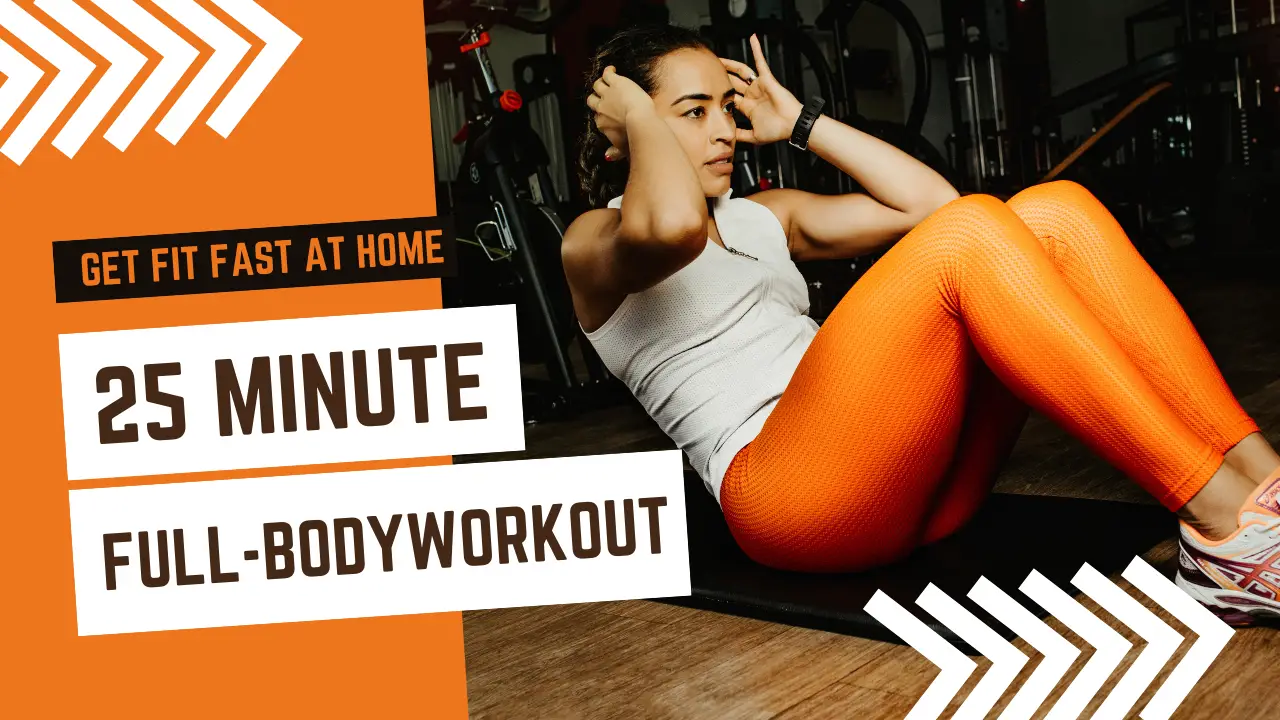
1 thought on “20-Minute Full-Body Workout: Get Fit Fast at Home”